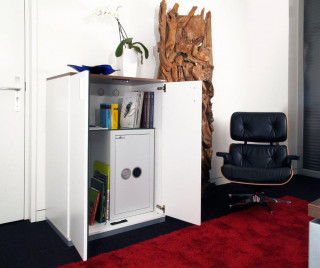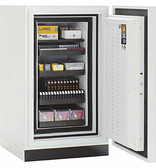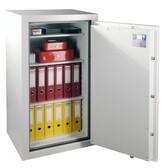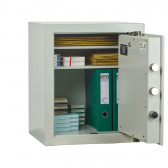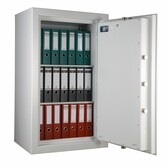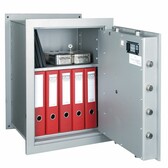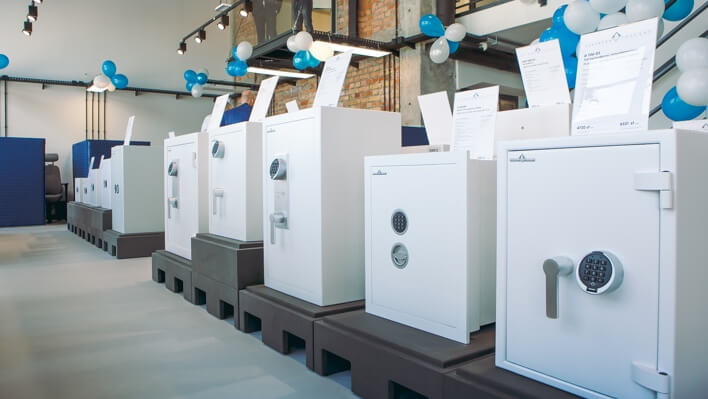We are operating in a digital age, where the vast majority of our business data is stored in the virtual world and communication has moved into the electronic sphere. It might therefore seem that office safes have lost their importance, that they are not needed and investing in them is a 'waste of money'. Nothing could be further from the truth. Safes and armoured cabinets are still an indispensable item used in business. Why? Because they protect what is important, valuable to us and what we cannot (or do not want to) store in the cloud: printed documents, data, valuables. Office safes are much more than just metal 'boxes' with locks. They are a symbol of security and trust; they help businesses (of all sizes and industries) to protect documents and assets, maintain data confidentiality, and comply with document storage regulations. In the following sections of this article, we will look at the different types of office safes, their advanced features, and how to properly choose a safe that suits your individual needs and the type of values you store. We will also learn about the benefits of using office safes in an organisation, ranging from protection against financial loss to increased operational efficiency and regulatory compliance. Ready for a deeper insight into the fascinating world of office safes?
Office safe – types
Office safes come in a variety of shapes and sizes to meet the different needs of businesses. Here are some popular types of office safes that will work well in business spaces:
• wall and floor safes – these provide effective protection against unauthorised access mainly because they are the most discreet, non-obvious solutions – as they are hidden in the wall or floor. It is worth preparing for the installation of this type of safe and planning a place for it e.g. at the stage of construction or renovation, as these types of safes should be immured in the wall or floor.
• furniture safes – ideally suited to small rooms, where space is limited, as they can be inserted, for example, into a built-in furniture. These safes are of a lower security class and are therefore offered for securing smaller values. The price of such safes is generally lower.
• free-standing safes – these safes offer a high level of protection and are adequate for securing valuable items. They offer more storage space.
• safes and metal cabinets with fireproofing – this is the category of safes that we recommend the most when it comes to storing values and documents in companies, as these safes not only protect against unauthorised access, but also against a random event such as a fire.
• safes for data carriers and electronics – protect data carriers from theft and damage thanks to increased resistance to high temperatures. Data carriers are sensitive to temperature rises, so a special category of safes is designed for this type of value.
• safes for storing weapons and ammunition – security companies as well as private gun owners often use safes for securing weapons and ammunition. They provide, above all, safe and, very importantly, legal storage of firearms.
• exclusive safes – it happens that safes from the exclusive line are ordered for the offices of CEOs or board members, which not only adequately protect values, but also look luxurious. Such a safe can, for example, be high-gloss lacquered on the outside (in any RAL colour), while on the inside it can be fitted with built-ins, drawers, partitions, watch winders, LED lighting. Beauty at the highest level.
Security classes for office safes
The security classes of safes indicate which burglary resistance the product provides. The higher the level of protection provided by a safe, the higher its burglary resistance class. The burglary resistance grade is given by independent institutions on the basis of tests to which the safes are subjected (generally speaking, the time it takes to partially and completely penetrate the safe, using various types of tools, is tested). The more robust the safe, the more time it takes to break into it, and this directly means a higher security class. Once a safe has passed the tests, it is certified in the appropriate burglary resistance class.
There are two European standards that allow safes to be classified according to specific classes: EN 14450 and EN 1143-1. The security classes of safes are also linked to the monetary values that can be stored in a given class (indicated by the Regulation of the Ministry of Internal Affairs and Administration of 7 September 2010 (permissible limit of stored values in each security class) on the requirements to be met by the protection of monetary values stored and transported by businesses and other organisational units):
EN 14450 – denotes cabinets and safes in resistance class:
• S1 – with the possibility of insuring the contents of the safe up to approximately 84,000 zlotys,
• S2 – with the possibility of insuring the safe's contents up to approx. 168,000 zlotys.
EN 1143-1 – denotes safes and armoured cabinets in classes:
• 0 – possibility of insuring a value of up to approx. 420,000 zlotys,
• I - insurable value up to approx. 840 000,
• II - insurable value up to approx. 1.2 million,
• III - insurable value up to approx. 2.5 million,
• IV - insurable value up to approx. 4.2 million,
• V - insurable value up to approx. 6.7 million zlotys.
If the connected safe is equipped with elements of an alarm system and connected to an alarm – the above values are even higher. Whenever you intend to insure the contents of a safe, consult this with your agent first – we know from experience that insurers require higher security classes than the above values would indicate.
Fire resistant safes and fire resistant metal cabinets – classification
In addition to burglary certification, some safes also have fire resistance classes. These are defined by the standards:
EN 15659:
• LFS 30 P: 30 minutes fire protection for paper documents,
• LFS 60 P: 60 minutes fire protection for paper documents;
EN 1047-1:
• S 60 P: 60 minutes fire protection for paper documents,
• S 120 P: 120 minutes fire protection for paper documents,
• S 60 DIS: 60 minutes fire protection for data carriers,
• S 120 DIS: 120 minutes fire protection for data carriers.
Locks used in office safes
In the lower security classes, the use of a single type of lock in the safe is sufficient. The basic price of a safe depends on which type of lock is fitted to it.
Key lock – a key is used to open the safe (two are included). The lowest price is a feature of this type of lock.
Cipher lock – to open the safe you need to set the appropriate cipher on the dial.
Electronic lock – access to the safe is possible after entering the correct PIN code (consisting of several digits).
Biometric lock – a fingerprint is used to open the safe.
We recommend an article on things that are important when changing the code in a safe.
Benefits of using office safes
There are many benefits to using office safes, including:
• protection against theft: items secured in a safe are accessible to a small group of people or to one person.
• security preservation: office safes provide secure storage of valuable items, documents and data, protecting them from unauthorised access. This is particularly important, for example in the context of personal data (RODO).
• confidentiality: classified documents and information are protected, helping to maintain secrecy from competitors or unauthorised persons.
• preventing losses: in the event of fire or flooding, fireproof safes prevent permanent damage to documents, valuables and data carriers.
• facilitating regulatory compliance: in some industries, there are regulations on document storage. Office safes help companies comply with these requirements.
Read also: Safe in the office – which one to choose?
The importance of office safes
Office safes play a significant role when it comes to securing documents, cash, storage media and anything that a company or institution defines as 'valuable'.
The use of safes in the office allows for:
• proper document protection: companies often store confidential and important documents such as contracts, financial documents or customer data. An office safe ensures their protection against unauthorised access and risks such as fires or flooding.
• safe storage of valuables: office safes allow cash, jewels, keys or other valuables to be stored safely. This is important for shops, hotels, banks and other places where valuables are collected.
• access management: modern office safes can be equipped with advanced access control systems, which make it possible to grant authorisation only to selected people. This makes it possible to keep track of who has tried to open the safe and when.
Summary
Both the safe and the armoured cabinet are indispensable tools in ensuring the security and protection of values in institutions and businesses. Various types of safes are available and their advanced features make them indispensable for storing valuables, documents and data. Investing in an office safe can make a significant contribution to security and peace of mind in the workplace.
We encourage you to visit our shop (we have two in Poland: one in Warsaw and one in Rzeszów), where, thanks to the exposition, you can see the individual products: we have many models of safes and various types of armoured cash boxes. Customers who wish to visit us are provided with free parking and the opportunity to speak to an experienced advisor, as well as the opportunity not only to view, but also to purchase the product on site. The regular price of the safes depends on their configuration and security level – basic models are available to suit all budgets.
